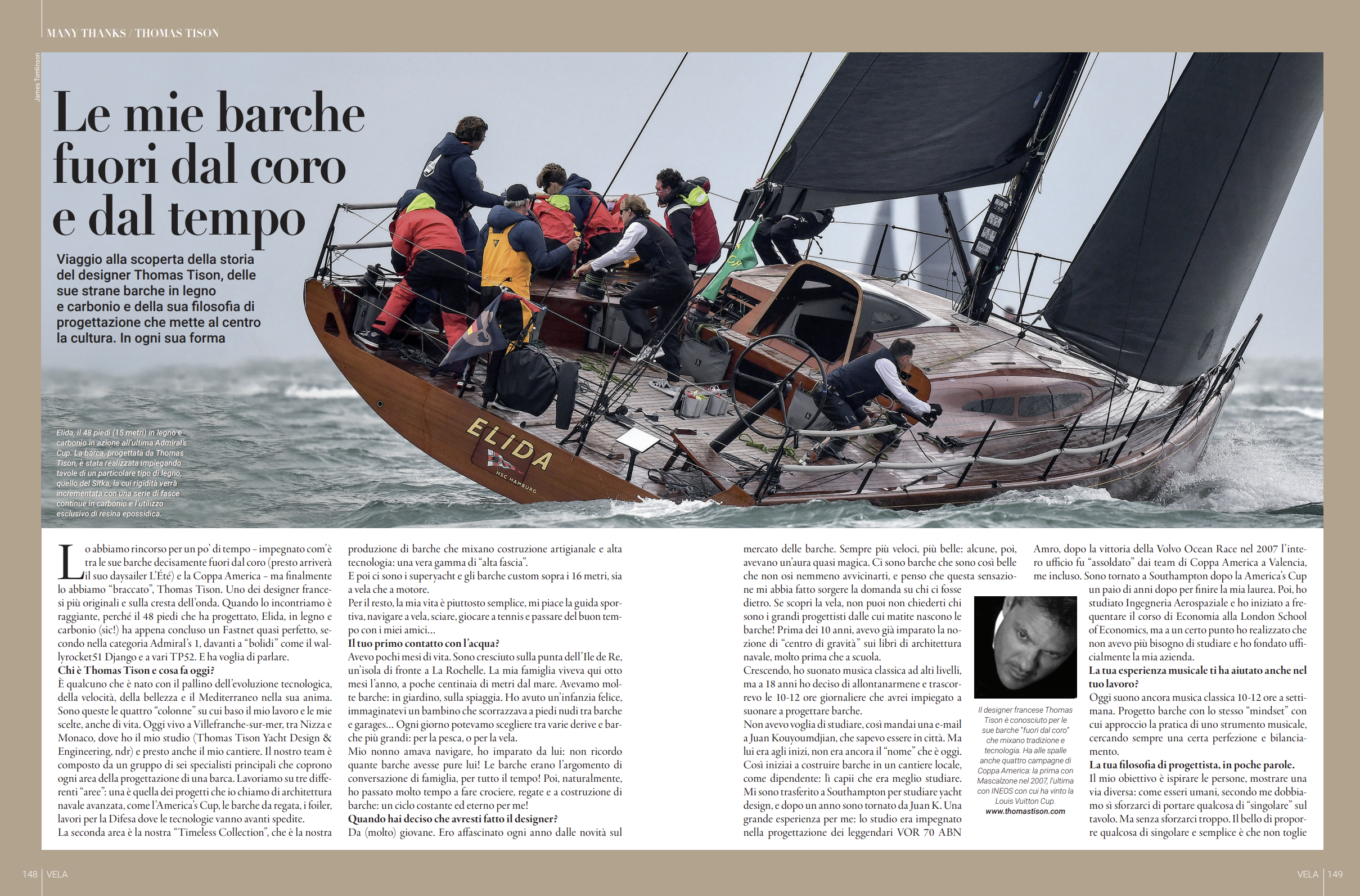GIORNALE DELLA VELA 50 YEARS
For a long time, I let the company grow on its own, but with more and more people discovering us, it became clear that I should share a bit more about myself.
Eugenio Ruocco, editor of Giornale Della Vela, reached out to me on the occasion of the magazine’s 50th anniversary, and I was happy to take part. I hope this interview gives you some insight into what drives me, where I come from, and my plans for the future. A huge thank you to the entire team for this initiative that celebrates the remarkable stories of modern sailing. I look forward to seeing what the next 50 years will bring!
TT
MY BOATS, FROM THE HEART, BEYOND TIME.
GIORNALE DELLA VELA
ENGLISH TRANSLATION OF ARTICLE – SEPTEMBER 2025 ISSUE

We chased him for a while – busy as he is with his decidedly unconventional boats (his daysailer L’Été will arrive soon) and the America’s Cup – but finally we “cornered” him, Thomas Tison. One of the most original French designers and currently at the peak of his career. When we meet him, he is radiant, because the 48-foot yacht he designed, Elida, in wood and carbon (yes, really!) has just completed an almost perfect Fastnet, finishing second in the Admiral’s 1 category, ahead of “speed machines” like the Wallyrocket51 Django and several TP52s. And he is eager to talk.
Who is Thomas Tison now?
I am someone who was born with a passion for technological evolution, speed, beauty, and the Mediterranean in my soul. These are the four “pillars” on which I base my work and my life choices. Today, I live in Villefranche-sur-Mer, between Nice and Monaco, where I have my studio (Thomas Tison Yacht Design & Engineering) and soon also my shipyard. Our team is composed of six main specialists covering every area of yacht design.
When did you first become interested in boats?
Since childhood, I was fascinated by boats. Some were faster, some more beautiful, and some even had an almost magical aura. There are boats so beautiful that you don’t even dare to approach them, and I think that feeling made me wonder who was behind them. Once you discover sailing, you can’t help but ask who the great designers are, the ones whose pencils bring these boats to life! Before I was ten, I had already learned the notion of “center of gravity” from naval architecture books, long before I studied it in school.
How did you start designing boats?
As I grew up, I played classical music at a high level, but at 18, I decided to leave that path and spent the 10–12 hours a day that I would have practiced music designing boats instead. I didn’t feel like studying, so I sent an email to Juan Kouyoumdjian, whom I knew was in town. But he was just starting out, not yet the “name” he is today. So I began building boats at a local shipyard as an employee: there I realized it was better to study. I moved to Southampton to study yacht design, and after a year I returned to Juan K. A great experience for me: the studio was working on the legendary VOR 70 ABN Amro, and after winning the Volvo Ocean Race in 2007, the entire office was “hired” by America’s Cup teams in Valencia, me included. I returned to Southampton after the America’s Cup a couple of years later to finish my degree. Then I studied Aerospace Engineering and started studying business at the London School of Economics, but at a certain point I realized I no longer needed to study and officially founded my company.
Did your musical experience help in your work?
I design boats with the same mindset I approach an instrument, always seeking a certain perfection and balance.
What I aim to do is to inspire people, to show a way forward, this is really at the center of how I create. I think as human we must all make the effort to bring something that’s singular to the table, but also without too much effort. The beauty of bringing something singular and simple is that it removes nothing from others, there is no competition, it just makes life nicer for all. With time, I have found I enjoy imagining the future, and this is the subject of the Advanced Naval Architecture Division where we work on subjects such as the America’s Cup, and foiling boats to one side. And to the other side our Timeless Line and custom yachts. Playing with the notion of time, either bringing the future back into the present, or bringing the past into the present is a way to create something that’s meaningful and different, without affecting the function itself which in sailing is important.
Why wood?
Wood has always been there in my life. Young I was raised sailing onboard a very nice wooden yacht, all varnished mahogany. On the other side of the family my grand parents had a wood furniture making factory, quite a large one, which had to close so I did not want to design boats in wood when I started designing boats. Wood was linked to amateur construction, tradition and a little slow, none of which interested me. But one day, I was asked to engineer the structure of Dream Symphony which is a 141 meter yacht designed by Dykstra, all in wood. Step by step, I found a way to make it work, and realized after this project that we could maybe create something of interest in wood, that there was perhaps a way forward.
The Exoskin method of construction I developed and we use now was born after this. With wood there is the warmth that I love, and the precious finish which forces us to behave differently on board. When we build a boat in wood we must bend the wood and there is a natural tendency to be a lot more careful with details, and sharp corners naturally disappear during the design process. A boat like our Timeless Line is like wearing a Tuxedo. There is a nice aspect to it.
What are the milestones of your career?
Starting with the recent past: seeing Elida battle for victory in her category at the Fastnet was wonderful. Every America’s Cup you participate in is also a big milestone: you immediately see the results of your design efforts on the field. With INEOS (the British America’s Cup team), I was the architect responsible for construction, reliability, and innovation behind some of the systems, and winning the Louis Vuitton Cup made me more than happy. The America’s Cup is not just sailing; it’s design competition, espionage, battles between teams, and extraordinary personalities. For pure sailing, today that’s SailGP. Today, I’m eagerly awaiting the launch of the shipyard where we will soon build our boats: design and construction must go hand in hand…
What did the America’s Cup teach you?
It’s very rare to find a place on earth where the best resources are gathered to develop and progress. When you build a normal boat, only a fraction of the budget goes to design, but here we are talking about multiples of the boat’s value, and an extra week of design can make the difference between losing or winning the America’s Cup. During my first America’s Cup in Valencia with Mascalzone Latino, I also discovered how important construction is for designing the best boats. You can’t design a foil if you don’t know what it’s made of. You can’t add more windows if you don’t understand the loads at sea… This combination of design and what we call structural engineering is at the heart of my work, and the two combined is what is commonly known as architecture. Now there is more exchange between what I bring to the America’s Cup and what the America’s Cup brings to me. For example, research we did on our Mini 6.50 prototype was applied to INEOS Britannia…
Designers who inspired you?
I am more inspired by artists (James Tissot in painting, the French multi-instrumentalist French Kiwi Juice in music), by Mediterranean culture, and by designers or architects outside sailing (Zaha Hadid, Norman Foster). But I certainly look at the legacy of Herreshoff or Fife to study how they handled certain situations. Both had their shipyards, both were involved in the America’s Cup, so they inspire me as a person more than as a designer…
Future projects?
We will soon commercially launch a foiling dinghy, and among all the projects, this is the one I’m most excited about. Not only will it come with technological advances, but also with financial innovation and design that embodies a lot of culture. Bringing culture back into sailing is fundamental today; it’s free and makes the world much more pleasant for everyone. I also can’t wait to see L’Été come to life, the new America’s Cup, and the superyachts that will emerge in the next five years…
Your first contact with water?
I was just a few months old. I grew up on the tip of Île de Ré, an island in front of La Rochelle. My family lived there eight months a year, just a few hundred meters from the sea. We had many boats: in the garden, on the beach. I had a happy childhood—imagine a child running barefoot among boats and garages… Every day we could choose among various dinghies and larger boats: for fishing or sailing. My grandfather loved sailing; I learned from him. I don’t remember how many boats he had either! Boats were the topic of family conversation all the time! Then, of course, I spent much time cruising, racing, and building boats: a constant, eternal cycle for me.

Discover the interview in the latest printed September Issue of Giornale Della Vela.

Recent Comments